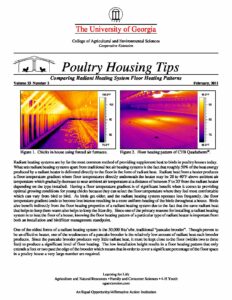Radiant heating systems are by far the most common method of providing supplement heat to birds in poultry houses today. What sets radiant heating systems apart from traditional hot air heating systems is the fact that roughly 50% of the heat energy produced by a radiant heater is delivered directly to the floor in the form of radiant heat. Radiant heat from a heater produces a floor temperature gradient where floor temperatures directly underneath the heater may be 20 to 40oF above ambient ai...r temperature which gradually decrease to near ambient air temperature at a distance of between 5' to 20' from the radiant heater depending on the type installed. Having a floor temperature gradient is of significant benefit when it comes to providing optimal growing conditions for young chicks because they can select the floor temperature where they feel most comfortable which can vary from bird to bird. As birds get older, and the radiant heating system operates less frequently, the floor temperature gradient tends to become less intense resulting in a more uniform heating of the birds throughout a house. Birds also benefit indirectly from the floor heating properties of a radiant heating system due to the fact that the same radiant heat that helps to keep them warm also helps to keep the litter dry. Since one of the primary reasons for installing a radiant heating system is to heat the floor of a house, knowing the floor heating pattern of a particular type of radiant heater is important from both an installation and bird/litter management standpoint.
One of the oldest forms of a radiant heating system is the 30,000 Btu’s/hr, traditional “pancake brooder”. Though proven to be an effective heater, one of the weaknesses of a pancake brooder is the relatively low amount of radiant heat each brooder produces. Since the pancake brooder produces very little radiant heat, it must be kept close to the floor (within two to three feet) to produce a significant level of floor heating. The low installation height results in a floor heating pattern that only extends a foot or two past the edge of the brooder which means that in order to cover a significant percentage of the floor space in a poultry house a very large number are required.
Radiant brooders (40,000 Btu’s/hr) produce a significantly greater amount of radiant heat than pancake brooders and as a result are typically installed five feet or more above the floor to help distribute the increased amount of radiant heat over a larger area. When properly installed/managed, the floor temperatures directly underneath a radiant brooder will run approximately 20 to 30oF above ambient air temperature decreasing to a couple of degrees roughly eight feet from the brooder. This creates a roughly 16' in diameter radiant heat zone (over twice that of a conventional pancake brooder) where the birds are receiving a majority of the heat they require directly from the brooder in the form of radiant heat. Outside this zone the birds are primarily being heated by the hot air produced by the radiant brooders in the house and as a result will run one to three degrees below air temperature. To obtain the maximum benefit from radiant brooders it is generally recommended that they be installed in the vicinity of the feed and water lines where radiant heat is most needed from a chick comfort and litter drying standpoint.......
Details
| Year | Volume | Number | Categories |
|---|---|---|---|
| 2011 | 23 | 2 |

